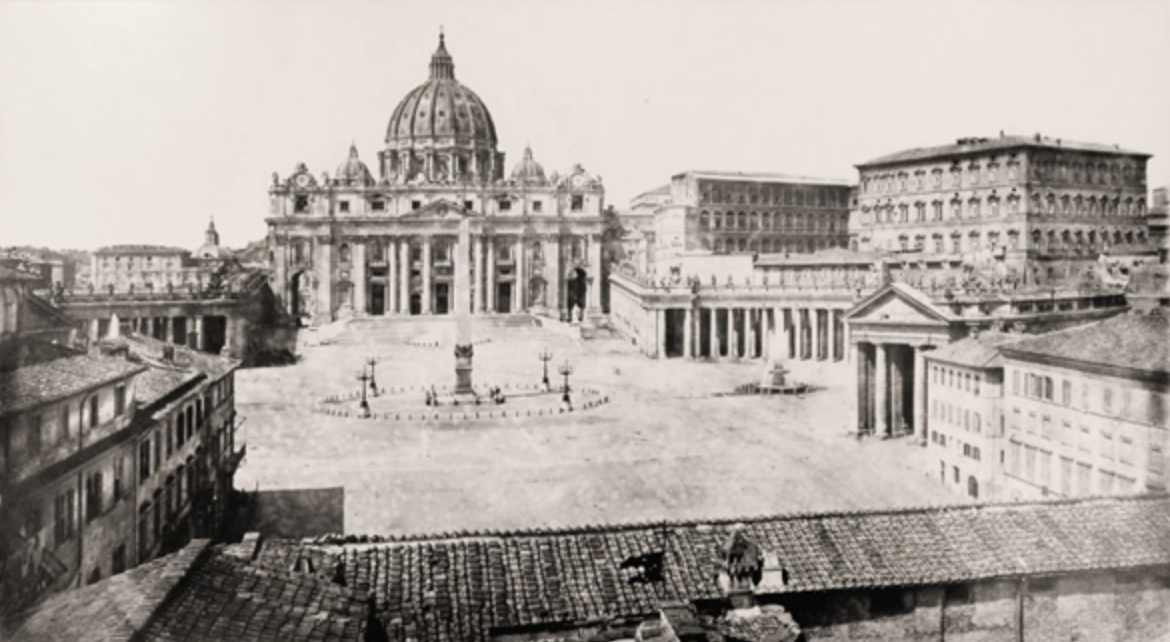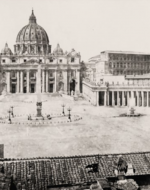Created by Stacey Smythe on Mon, 04/26/2021 - 18:10
Description:
Reflecting the cumulative efforts of no less than a half dozen significant architects, spanning the succession of twenty pontifcates, and witnessing the passage of one hundred and twenty years from groundbreaking to consecration, St. Peter’s Basilica (Basilica di San Pietro) is the culmination a two-thousand year campaign to both formally and grandly mark the presumed burial site of St. Peter, the first bishop of Rome, and erect an unprecedented and unparalleled paean to Catholicism. Replacement of the neglected and dilapidated 4th-century church built by Constantine, the Roman Empire’s first Christian emperor, was first considered by Pope Nicholas V as early as the mid-15th century, but doing so was not actively pursued until 1506 when Pope Julius II commissioned Donato Bramante to replace the old basilica with a structure that, ”[w]as to take the place of a building teeming with venerable memories," and that in so doing it "was to embody the greatness of the present and the future” (McClendon 46). Tradition holds that Bramante’s original design called for a Greek cross plan with a centrally placed dome modeled on that of the Pantheon. It was a design that Palladio—the Italian Renaissance architect active primarily in the Venetian Republic and noted for his villas and country homes—wrote would be “[t]he first to bring back to the light of day the good and beautiful architecture that had been hidden since the time of the ancients" (McClendon 48). Ironically, Bramante undermined much of the projects intention as, according to Giorgio Vasari—the 16th-century painter and historian—he "[w]as so anxious for the work to progress that he destroyed in [old] St. Peter's many fine tombs of popes, paintings and mosaics, thus obliterating the memory of many portraits of great men scattered about the principal church of Church of Christendom” (McClendon 48). Bramante’s plans for the basilica itself would be amended and reworked by Michelangelo—whose dome remains the most distinguishable and tallest in all of Christendom, and the project would evolve to the include the development of the imposingly barren area—save for the four-thousand-year-old cross-capped Egyptian obelisk brought to Rome the emperor Caligula in 37 CE—in front of the church, the most salient and most controversial feature of which was Bernini’s colonnade. Of his design Bernini wrote: “Since St. Peter's is, so to speak, the Mother Church to all other churches, the portico accurately expresses her act of maternally receiving in her open arms Catholics to be confirmed in the faith, heretics to be reunited with the Church, and unbelievers to be enlightened by the true faith” (McClendon 41). Much of the 19th-century criticism of the colonnade was directed toward Bernini’s baroque ornateness and blatant Counter-Reformation zeal, particularly as evidenced by the addition of 140 statues of saints that punctuate the edges of the roof of the walkway composed of four ranks of Doric columns, no less than two-hundred in number. Claude echoes the prevalent opinion of 19th-century art historians and critics, and all but quotes—going so far as to lift the word ”rubbishy”—his Oxford classmate and noted Victorian Era critic, John Ruskin who wrote, “St. Peter’s I expected to be disappointed in. I was disgusted…As a whole, St. Peter’s is fit for nothing but a ballroom and it is a little too gaudy even for that…The Capitol is a melancholy rubbishy square of average Palladian-modern” (Crawford 393). By the early 20th-century, negative criticism of both the Basilica and the Baroque had been replaced by appreciation, if not exactly enthusiasm, due in large part to the reassessment of Bernini’s work by the German-born British art historian Rudolf Wittkower who wrote: “Bernini’s Piazza di San Pietro was such an ingenious and complicated piece of planning that it could not fail to arouse contemporary criticism. He had not only to deal with a vast number of practical architectural difficulties, he had also to provide for religious, liturgical and ceremonial requirements and last but not least to satisfy the taste of his time. Critics attacked him from all of these angles according to their own points of view” (Wittkower 88). Despite the trend toward the disparaging, not all 19th-century British visitors to St. Peter’s were disappointed. In his 1846 Pictures from Italy, Charles Dickens—reflecting upon his arrival at St. Peter’s in the winter of 1845—commented: “It looked immense in the distance, but distinctly and decidedly small, by comparison, on a near approach. The beauty of the Piazza, on which it stands, with its clusters of exquisite columns and its gushing fountains—so fresh, so broad, and free, and beautiful—nothing can exaggerate. The first burst of the interior, in all its expansive majesty and glory: and, most of all, the looking up into the Dome: is a sensation never to be forgotten” (Dickens 80). Although the symbol of Catholicism—and all but synonymous with the papacy, and despite its magnitude and magnificence, St. Peter’s is neither the mother church of the Catholic Church, nor even the cathedral of the Roman Diocese; the Archbasilica of San Giovanni in Laterano (St. John Lateran) holds these distinctions.
Copyright:
Associated Place(s)
Part of Group:
Featured in Exhibit:
Artist:
- Robert MacPherson


